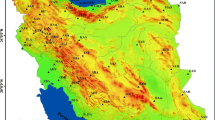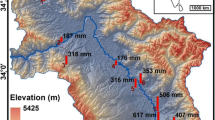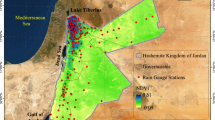Abstract
Satellite retrieval of precipitation is a great challenge in arid regions where light precipitation prevails. To improve the accuracy of satellite precipitation products in Xinjiang, which is the driest region in China, this study first evaluated the performance of two widely used monthly satellite products from April 2014 to August 2017. The first was the Tropical Rainfall Measuring Mission (TRMM) 3B43 version 7 (hereafter 3B43V7), and the second was the Integrated Multi-Satellite Retrievals for the Global Precipitation Measurement (GPM) mission (IMERG) (hereafter 3IMERGM). The 3IMERGM product was then corrected by a stepwise regression model using topographic variables derived from digital elevation model (DEM). A comparison between satellite estimates and in situ measurements indicates that both 3B43V7 and 3IMERGM overestimate precipitation overall, but that 3IMERGM performs better than 3B43V7. The relative biases (RB) of 3B43V7 and 3IMERGM were found to be 10.24 and 7.76%, respectively. The correlation coefficient (CC) between 3IMERGM and the gauges is 0.68, which is higher than the CC observed (i.e., 0.62) between 3B43V7 and the gauges. To comprehensively evaluate the performance of the corrected model, a tenfold cross-validation method was used. The results showed that the corrected 3IMERGM (C-3IMERGM) performed much better than 3IMERGM. Specifically, CC was increased from 0.68 to 0.73, and RB is decreased from 7.76 to − 1.65%. Furthermore, C-3IMERGM achieves a better precipitation distribution than the uncorrected satellite product and even than scarce gauge measurements. The actual spatial pattern of precipitation represented that the precipitation bands in the Kunlun Mountains located in southern Xinjiang were captured by C-3IMERGM, but missed by the other products.









Similar content being viewed by others
References
AghaKouchak A, Mehran A, Norouzi H, Behrangi A (2012) Systematic and random error components in satellite precipitation data sets. Geophys Res Lett 39:L09406. https://doi.org/10.1029/2012GL051592
Barros AP, Lettenmaier DP (1992) Dynamic modeling of the spatial distribution of precipitation in remote mountainous areas. Mon Weather Rev 121:1195–1214
Barros AP, Lettenmaier DP (1994) Dynamic modeling of orographically induced precipitation. Rev Geophys 32:265–284
Basist A, Bell GD (1994) Statistical relationships between topography and precipitation patterns. J Climate. https://doi.org/10.1175/1520-0442(1994)007
Beale EML, Kendall MG, Mann DW (1967) The discarding of variables in multivariate analysis. Biometrika 54:357–366. https://doi.org/10.2307/2335028
Blacutt L, Herdies D, Goncalves L, Vila D, Andrade M (2015) Precipitation comparison for the CFSR, MERRA, TRMM3B42 and combined scheme datasets in Bolivia. Atmos Res 163:117–131. https://doi.org/10.1016/j.atmosres.2015.02.002
Bro R, Smilde AK (2014) Principal component analysis. Anal Methods 6(9):2812–2831. https://doi.org/10.1039/c3ay41907j
Chatzithomas C, Alexandris S, Karavitis C (2015) Multivariate linear relation for precipitation: a new simple empirical formula. Stud Geophys Geod. https://doi.org/10.1007/s11200-013-1162-6
Crochet P (2009) Enhancing radar estimates of precipitation over complex terrain using information derived from an orographic precipitation model. J Hydrol 377:417–433. https://doi.org/10.1016/j.jhydrol.2009.08.038
Ferraro RR, Smith EA, Berg W, Huffman GJ (1998) A screening methodology for passive microwave precipitation retrieval algorithms. J Atmos Sci 55:1583–1600. https://doi.org/10.1175/1520-0469(1998)055,1583:ASMFPM.2.0.CO;2
Golian S, Moazami S, Kirstetter PE, Hong Y (2015) Evaluating the performance of merged multi-satellite precipitation products over a complex terrain. Water Resour Manag 29:4885–4901. https://doi.org/10.1007/s11269-015-1096-6
Groisman PV, Legates DR (1994) The accuracy of United States precipitation data. Bull Am Meteorol Soc 75:215–227
Guan H, Wilson JL, Makhnin O (2005) Geostatistical mapping of mountain precipitation incorporating autosearched effects of terrain and climatic characteristics. J Hydrometeorol. https://doi.org/10.1175/JHM448.1
Guo H, Chen S, Bao A, Behrangi A, Hong Y, Ndayisaba F, Hu J, Stepanian PM (2016) Early assessment of integrated multi-satellite retrievals for global precipitation measurement over China. Atmos Res. https://doi.org/10.1016/j.atmosres.2016.02.020
Habib E, Ciach G, Krajewski W (2004) A method for filtering out rain gauge representativeness errors from the verification distributions of radar and rain gauge rainfall. Adv Water Resour 27:967–980
Hirpa FA, Gebremichael M, Hopson T (2010) Evaluation of high-resolution satellite precipitation products over very complex terrain in Ethiopia. J Appl Meteorol Climatol 49:1044–1051. https://doi.org/10.1175/2009JAMC2298.1
Hou AY, Kakar RK, Neeck S, Azarbarzin AA, Kummerow CD, Kojima M, Oki R, Nakamura M, Iguchi T (2014) The global precipitation measurement mission. Bull Am Meteorol Soc 95(5):701–722
Hu Z, Hu Q, Zhang C, Chen X, Li Q (2016) Evaluation of reanalysis, spatially-interpolated and satellite remotely-sensed precipitation datasets in Central Asia. J Geophy Res. https://doi.org/10.1002/2016jd024781
Huang A, Zhao Y, Zhou Y, Yang B, Zhang L, Dong X, Fang D, Wu Y (2016) Evaluation of multisatellite precipitation products by use of ground-based data over China. J Geophys Res Atmos. https://doi.org/10.1002/2016JD025456
Huffman GJ, Bolvin DT (2017) TRMM and other data precipitation data set documentation. http://pmm.nasa.gov/sites/default/files/document_files/3B42_3B43_doc_V7_4_19_17.pdf
Huffman G, Bolvin D, Nelkin E, Wolff D, Adler R, Gu G, Hong Y, Bowman K, Stocker E (2007) The TRMM multisatellite precipitation analysis (TMPA): quasi-global, multiyear, combined-sensor precipitation estimates at fine scales. J Hydrometeorol 8(1):38–55
Huffman GJ, Adler RF, Bolvin DT, Nelkin EJ (2009) The TRMM multi-satellite precipitation analysis (TMPA). In: Gebremichael M, Hossain F (eds) Satell Appl Surf Hydrol. Springer, Dordrecht, pp 3–22. https://doi.org/10.1007/978-90-481-2915-7_1
Huffman GJ, Bolvin DT, Braithwaite D, Hsu K, Joyce R, Kidd C, Nelkin EJ, Xie P (2017a) NASA global precipitation measurement (GPM) integrated multi-satellite retrievals for GPM (IMERG) algorithm theoretical basis document (ATBD) Version 4.5. http://pmm.nasa.gov/sites/default/files/document_files/IMERG_ATBD_V5.1b
Huffman GJ, Bolvin DT, Nelkin EJ (2017b) Integrated multi-satellite retrievals for GPM (IMERG) technical documentation. http://pmm.nasa.gov/sites/default/files/document_files/IMERG_doc_171117b.pdf
Hutchinson P (1973) The interaction of relief and synoptic situation on the distribution of storm rainfall in the vicinity of Dunedin. NZ Geogr 29:31–44. https://doi.org/10.1111/j.1745-7939.1973.tb00691.x
Ji X, Chen Y (2012) Characterizing spatial patterns of precipitation based on corrected TRMM 3B43 data over the mid Tianshan Mountains of China. J Mt Sci 9:628–645
Joyce RJ, Janowiak JE, Arkin PA, Xie P (2004) CMORPH: a method that produces global precipitation estimates from passive microwave and infrared data at high spatial and temporal resolution. J Hydrometeorol 5(3):487–503
Kaiser HF (1958) The varimax criterion for analytic rotation in factor analysis. Psychometrika 23(3):187–200
Karavitis CA, Kerkides P (2002) Estimation of the water resources potential in the Island system of the Aegean Archipelago, Greece. Water Int 27:243–254. https://doi.org/10.1080/02508060208686998
Kubota T, Shige S, Hashizurne H, Aonashi K, Takahashi N, Seto S, Hirose M, Takayabu YN, Ushio T, Nakagawa K, Wanami K, Kachi M, Okamoto K (2007) Global precipitation map using satellite-borne microwave radiometers by the GSMaP project: production and validation. IEEE Trans Geosci Remote Sens 45(7):2259–2275
Legates D, Willmott C (1990) Mean seasonal and spatial variability in gauge-corrected, global precipitation. Int J Climatol 10:111–127
Li Q, Chen Y, Shen Y, Li X, Xu J (2011a) Spatial and temporal trends of climate change in Xinjiang, China. J Geogr Sci 21(6):1007–1018
Li X, Jiang F, Lia L, Wang G (2011b) Spatial and temporal variability of precipitation concentration index, concentration degree and concentration period in Xinjiang, China. Int J Climatol 31:1679–1693. https://doi.org/10.1002/joc.2181
Li Y, Yao N, Sahin S, Appels WM (2016) Spatiotemporal variability of four precipitation-based drought indices in Xinjiang, China. Theor Appl Climatol. https://doi.org/10.1007/s00704-016-1827-5
Liu C, Zipser E (2015) The global distribution of largest, deepest, and most intense precipitation systems. Geophys Res Lett 42(9):3591–3595
Ma L, Zhang T, Frauenfeld O, Ye B, Yang D, Qin D (2009) Evaluation of precipitation from the ERA-40, NCEP-1, and NCEP-2 reanalysis and CMAP-1, CMAP-2, and GPCP-2 with ground-based measurements in China. J Geophys Res 114:D09105. https://doi.org/10.1029/2008JD011178
Ma Y, Zhang Y, Yang D, Farhan SB (2014) Precipitation bias variability versus various gauges under different climatic conditions over the Third Pole Environment (TPE) region. Int J Climatol. https://doi.org/10.1002/joc.4045
Maggioni V, Saplano MRP, Adler RF (2016) Estimating uncertainties in high-resolution satellite precipitation products: systematic or random error? J Hydrometeorol 17:1119–1129. https://doi.org/10.1175/JHM-D-15-0094.1
Michaud JD, Auvine BA, Penalba OC (1995) Spatial and elevational variations of summer rainfall in the Southwestern United States. J Appl Meteorol 34(12):2689–2703
Newton RG, Spurrell DJ (1967) A development of multiple regression for the analysis of routine data. Appl Stat 16:51–64
Ouallouche F, Ameur S (2014) Rainfall detection over northern Algeria by combining MSG and TRMM data. Appl Water Sci 6:1–10. https://doi.org/10.1007/s13201-014-0204-8
Roe GH, Montgomery DR, Hallet B (2002) Orographic precipitation and the relief of mountain ranges. J Geophys Res 108(B6):2315. https://doi.org/10.1029/2001jb001521
Shen Y, Pan Y, Yu J, Zhao P, Zhou Z (2013) Quality assessment of hourly merged precipitation product over China. Trans Atmos Sci 36(1):37–46. https://doi.org/10.13878/j.cnki.dqkxxb.2013.01.005 (in Chinese)
Shige S, Kida S, Ashiwake H, Kubota T, Aonashi K (2013) Improvement of TMI rain retrievals in mountainous areas. J Appl Meteorol Climatol 52:242–254
Shige S, Yamamoto MK, Taniguchi A (2014) Improvement of TMI rain retrieval over the Indian Subcontinent. In: Lakshmi V (ed) Remote sensing of the terrestrial water cycle, Geophysical monograph 206. American Geophysical Union, pp 27–42
Sinclair MR, Wratt DS, Henderson RD, Gray WR (1997) Factors affecting the distribution and spillover of precipitation in the Southern Alps of New Zealand—a case study. J Appl Meteorol 36(5):428–442
Smith RB (1979) The influence of mountains on the atmosphere. Adv Geophys 21(4):87–217
Sorooshian S, Hsu KL, Gao X, Gupta HV, Imam B, Braithwaite D (2000) Evaluation of PERSIANN system satellite-based estimates of tropical rainfall. Bull Am Meteorol Soc 81(9):2035–2046
Tan X, Shao D (2016) Precipitation trends and teleconnections identified using quantile regressions over Xinjiang. Int J Climatol. https://doi.org/10.1002/joc.4794
Tang G, Long D, Hong Y (2016a) Systematic anomalies over land water bodies of High Mountaion Asia in TRMM precipitation estimates: no longer a problem for the GPM era? IEEE Geosci Remote Sens Lett. https://doi.org/10.1190/LGRS.2016.2606769
Tang G, Ma Y, Long D, Zhong L, Hong Y (2016b) Evaluation of GPM Day-1 IMERG and TMPA Version-7 legacy products over Mainland China at multiple spatiotemporal scales. J Hydrol 533:152–167
Tang G, Zeng Z, Long D, Guo X, Yong B, Zhang W, Hong Y (2016c) Statistical and hydrological comparisons between TRMM and GPM Level-3 products over a midlatitude basin: is day-1 IMERG a good successor for TMPA 3B42V7? J Hydrometeorol 17(1):121–137
Taniguchi A, Shige S, Yamamoto MK, Mega T, Kida S, Kubota T, Kachi M, Ushio T, Aonashi K (2013) Improvement of high-resolution satellite rainfall product for Typhoon Morakot (2009) over Taiwan. J Hydrometeorol 14:1859–1871
Villarini G, Krajewski WF (2008) Empirically-based modeling of spatial sampling uncertainties associated with rainfall measurements by rain gauges. Adv Water Resour 31(7):1015–1023
Ward E, Buytaert W, Peaver L, Wheater H (2011) Evaluation of precipitation products over complex mountainous terrain: a water resources perspective. Adv Water Resour 34(10):1222–1231. https://doi.org/10.1016/j.advwatres.2011.05.007
Willmott CJ (1981) On the validation of model. Phys Geogr 2:184–194. https://doi.org/10.1080/02723646.1981.10642213
Wu C, Chen JM (2012) The use of precipitation intensity in estimating gross primary production in four northern grasslands. J Arid Environ 82:11–18
Xu J, Chen Y, Li W, Liu Z, Tang J, Wei C (2016) Understanding temporal and spatial complexity of precipitation distribution in Xinjiang, China. Theor Appl Climatol 123:321–333
Yamamoto MK, Shige S (2015) Implementation of an orographic/nonorographic rainfall classification scheme in the GSMaP algorithm for microwave radiometers. Atmos Res 163:36–47. https://doi.org/10.1016/j.atmosres.2014.07.024
Yang Y, Luo Y (2014a) Using the back propagation neural network approach to bias correct TMPA data in the arid region of Northwest China. J Hydrometeorol 15(1):459–473
Yang Y, Luo Y (2014b) Evaluating the performance of remote sensing precipitation products CMORPH, PERSIANN, and TMPA, in the arid region of northwest China. Theor Appl Climatol 118:429–445
Yin ZY, Liu X, Zhang X, Chung CF (2004) Using a geographic information system to improve Special Sensor Microwave Imager precipitation estimates over the Tibetan Plateau. J Geophys Res Atmos 109:2004. https://doi.org/10.1029/2003JD003749
Yin ZY, Zhang X, Liu X, Colella M, Chen X (2008) An assessment of the biases of satellite rainfall estimates over the Tibetan Plateau and correction methods based on topographic analysis. J Hydrometeorol 9(3):301–326
Yong B, Liu D, Gourley JJ, Tian Y, Huffman GJ, Ren L, Hong Y (2015) Global view of real-time TRMM multisatellite precipitation analysis: implications for its successor global precipitation measurement mission. Bull Am Meteorol Soc 96(2):283–296
Zhang Q, Singh VP, Li J, Jiang F, Bai Y (2012) Spatio-temporal variations of precipitation extremes in Xinjiang, China. J Hydrol 434–435:7–18
Zhang Y, Ge Q, Liu M (2015) Extreme precipitation changes in the semiarid region of Xinjiang, Northwest China. Adv Meteorol. https://doi.org/10.1155/2015/645965
Zhao C, Ding Y, Ye B, Yao S, Zhao Q, Wang Z, Wang Y (2011) An analyses of long-term precipitation variability based on entropy over Xinjiang, northwestern China. Hydrol Earth Syst Sci Dis 8(2):2975–2999
Acknowledgements
This work was supported by the National Natural Science Foundation of China (41675029, 41565003 and U170310011), the Project of State Key Laboratory of Severe Weather of Chinese Academy of Meteorological Sciences (2016LASW-B12), the Postgraduate Innovation Program of Jiangsu (KYLX15_0864), the Basic Research Operating Expenses of the Central Level Non-profit Research Institutes (IDM2016002), and the Xinjiang Uygur Autonomous Region high-level personnel funding (2017-41). We are grateful to the scientists in NASA science team for providing satellite precipitation data and DEM data. Both 3B43V7 and IMERG data were obtained from the Precipitation Measurement Missions (PMM) web site (http://pmm.nasa.gov/). The DEM data were obtained from the NASA website (http://reverb.echo.nasa.gov/reverb/). We thank Xinjiang Meteorological Information Center for providing the gauge observed precipitation data.
Author information
Authors and Affiliations
Corresponding authors
Rights and permissions
About this article
Cite this article
Lu, X., Wei, M., Tang, G. et al. Evaluation and correction of the TRMM 3B43V7 and GPM 3IMERGM satellite precipitation products by use of ground-based data over Xinjiang, China. Environ Earth Sci 77, 209 (2018). https://doi.org/10.1007/s12665-018-7378-6
Received:
Accepted:
Published:
DOI: https://doi.org/10.1007/s12665-018-7378-6




